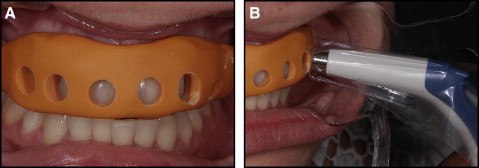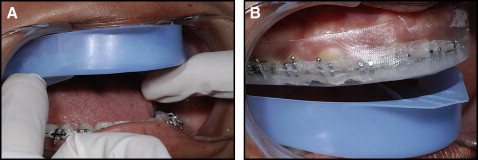Introduction
Our objective was to assess the effectiveness of a new bleaching agent (8% hydrogen peroxide) used in patients wearing fixed orthodontic appliances.
Methods
Six anterior maxillary teeth of 40 patients aged 18 to 40 years were assessed. The patients were divided into 2 groups (20 in each group): in group A, the patients used the bleaching agent during orthodontic treatment; in group B, the patients used the bleaching agent after orthodontic treatment. For each group, a record of the initial tooth shade was taken with a polyvinyl siloxane matrix and a spectrophotometer. The groups had bleaching treatments with an 8% hydrogen peroxide product (Opalescence Treswhite Ortho, Ultradent, Opal Orthodontics, South Jordan, Utah) for 10 days in 45-minute sessions. For group A, the treatment was performed 10 days before finishing orthodontic treatment; at the end of the treatment, a new tooth shade record was taken with the polyvinyl siloxane matrix and a spectrophotometer. The subjects in group B had the same bleaching protocol after their brackets were removed.
Results
It was observed that, for the group without brackets, the color alteration ranged from 3 to 12 (mean, 8; median, 8.3); for the group with brackets, the range was between 4 and 13 (mean, 9; median, 8.5), indicating significant tooth bleaching in both groups with and without brackets ( P >0.05).
Conclusions
Opalescence Treswhite Ortho was shown to be an efficient bleaching agent in patients wearing fixed orthodontic appliances.
The popularity of dental bleaching has increased since 1989, and it is now frequently used in most dental procedures. This procedure consists of the application of hydrogen peroxide-based gel, first described by Kingsbury in 1861, and carbamide peroxide. Bleaching treatments in healthy teeth can be performed at home or at dental offices under professional supervision, and their popularity can be explained by the many bleaching products on the market. Because it is easy to perform more conservative treatments to lighten teeth, bleaching offers patients a minimally invasive treatment with excellent esthetic results.
Many young and adult patients are reluctant to wear fixed orthodontic appliances on their teeth because of the unattractive appearance when these treatments are performed. In addition to this phenomenon, patients who suffer color alterations of their teeth because of difficulty in performing oral hygiene are more likely to reject these treatments. It has been reported that tooth-whitening products can be used before or after orthodontic treatment; however, in a previous study, the use of bleaching agents before adhesive procedures with resin materials, such as those used to bond orthodontic appliances, was questioned.
Because most patients wearing orthodontic appliances perceive alterations in the shade of their teeth once treatment is interrupted and they attribute these stains to the treatment, it is important to provide them with orthodontic appliances for esthetic satisfaction and the possibility that their teeth will have a socially acceptable color during treatment. Hydrogen peroxide whitens the teeth poly-directionally, even in areas covered by orthodontic appliances; this makes it possible to achieve a whitening effect under the appliances.
To fulfill the esthetic needs of patients wearing orthodontic appliances, a product called Opalescence Treswhite Ortho (Ultradent, Opal Orthodontics, South Jordan, Utah) has been developed.
Treswhite Ortho is presented with a semirigid external tray and a second highly flexible tray for home or in-office use, easily adaptable to the topography of the teeth and the brackets. This preloaded flexible tray contains 8% hydrogen peroxide, fluoride, and potassium nitrate, which must be kept on the brackets for about 45 minutes to achieve adequate contact time between the whitening gel, the teeth, and the brackets. After each 45-minute daily session, the flexible tray is easily removed from the mouth and discarded. After that, the patient can remove any remaining gel by brushing the teeth. Although previous studies have already investigated similar products as used in this study, no clinical studies assessing this material were found in the literature. Based on the above-mentioned explanation, the aim of this study was to clinically assess the effectiveness of this new 8% hydrogen peroxide-based bleaching agent in patients wearing fixed orthodontic appliances. The null hypothesis was that the bleaching agent would have the same effect with or without the brackets.
Material and methods
The study was approved by the Ethics Research Committee of the Universidad Santiago de Cali, in Cali, Colombia. Before enrollment, each subject received an informed consent form containing all the information regarding the risks and benefits of treatment. All participants signed the consent form. A total of 6 anterior maxillary teeth of 40 patients referred for orthodontic treatment, aged between 18 and 40 years, who were not pregnant or breast feeding, and were nonsmokers, were assessed, totaling 240 teeth without caries, restorations, pigmentations, stains, or periodontal disease. The 40 patients were divided into 2 groups (n = 20). In group A, the patients used the bleaching agent during orthodontic treatment; in group B, the patients used the bleaching agent after orthodontic treatment.
For both groups, color measurements were made with a VITA Easyshade spectrophotometer (Easyshade, Vident, Brea, Calif) before applying the bleaching agent. The measurements were made by 1 operator (E.J.) using a preestablished matrix made of high-viscosity silicone (Zetalabor, Zhermack, Polesine Badia, Italy). This matrix was made individually for each patient. In the matrix, there was a circular opening located on the central part of the buccal or oral surface of tooth to be measured; it was configured with the help of a circular metal cutting device measuring 5 mm in diameter. This matrix served as the standardized guide to measure the color with the spectrophotometer ( Fig 1 ).

For the calibration procedure, an experienced clinician and a technician performed the color measurement and bleaching procedure to identify all of the steps involved in the use of the EasyShade. Then the operator used the device under the direct supervision of the experienced clinician. All problems during this procedure were shown to the operator before starting the study. Only after that, the operator was considered calibrated to perform the bleaching procedure.
For group A, the initial color of the teeth was recorded by using the VITA Easyshade spectrophotometer ( Fig 1 , B ), before bonding the brackets. Once the brackets were bonded, the new bleaching agent with 8% hydrogen peroxide (Opalescence Treswhite Ortho) was applied ( Fig 2 ), for 10 consecutive days in 45-minute daily sessions, 10 days before finishing orthodontic treatment. After the brackets were removed ( Fig 3 ), the enamel surfaces were adequately cleaned, and the final color was measured again with the VITA Easyshade spectrophotometer.


For Group B, after finishing orthodontic therapy, the brackets were removed, the enamel surfaces were adequately cleaned, and the initial color of the teeth was recorded with the VITA Easyshade spectrophotometer. Then the same bleaching agent was used. This was used for 10 consecutive days in 45-minute daily sessions; on day 10, the color was measured again with the spectrophotometer.
Because it is a new product on the market and to prevent patients from interrupting its use, as could happen at home, this study was carried out under professional supervision in a dental office. For both groups, the bleaching processes and the color records during the 15-month study period were standardized and performed by 1 operator (G.A.).
The data obtained with the VITA Easyshade spectrophotometer in the 2 groups were recorded, based on the colors of the shade guide VITA Classic Scale (VITA, Zahnfabrik, Bad Sackingen, Germany). To facilitate the statistical procedures, the colors of the shade guide were organized from the highest to the lowest values ( Fig 4 ). Each shade was represented by a numeric value in a continuous scale from 1 to 16.


Stay updated, free dental videos. Join our Telegram channel

VIDEdental - Online dental courses


